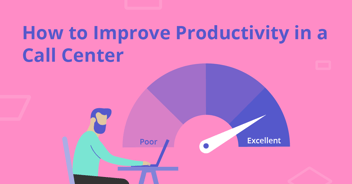5 Tips for a Successful Contact Center Agent Onboarding Process

You’ve wrapped up an extensive round of interviews and have recruited new agents for your contact center team.
Now comes the next phase—onboarding.
Agent onboarding consists of three critical steps: the training program, post-training ramp to proficiency, and the achievement of full proficiency.
The onboarding process can make or break the agent experience in your contact center. New agents face significant pressure, and ineffective, lengthy training and onboarding means higher turnover and lower engagement. That’s why prioritizing the initial months of an agent’s tenure is crucial for ensuring high levels of employee and customer satisfaction.
Guarantee that your contact center agents are prepared for their role in an optimal amount of time with our five top tips for developing a successful agent onboarding process.
The importance of agent onboarding
The onboarding process can mean the difference between happy agents who succeed in their role and dissatisfied agents who eventually quit.
Onboarding has as much to do with helping agents feel confident during customer interactions as it does with the complex processes they need to retain. And when teaching methods are impractical or insufficient, it hinders learning and has negative consequences for everyone involved. 
- It affects the reputation of your company. The productivity of tenured agents takes a hit as they are required to fill the gaps until new hires can reach proficiency. Inadequately prepared agents have low performance, revealing to customers that things aren’t running optimally behind the scenes. Word gets around, either through dissatisfied customers or frustrated agents, and your brand’s reputation declines as reflected in negative reviews.
- It affects the customer experience. Simply put—dissatisfied customers leave for competitors. Happy customers remain loyal to your organization.
- It affects the employee experience. Agents must feel confident that they’re ready to take on all aspects of the job. Anything less can lead to disengagement, and ultimately, departure. A new hire’s introduction to the company—its processes, technology, goals, and culture needs to start strong.
“While it’s true that employees are interested in how much they are going to get paid and all those types of things, what they really want to know is: What am I going to learn? Who am I going to help? And what kinds of relationships am I going to form?”
— Dick Finnegan, Employee Retention Expert
How effective agent onboarding contributes to success
First impressions are the most significant in shaping the trajectory of new hires.
The onboarding process sets the tone for agents to familiarize themselves with their role, establish connections with supervisors, and recognize their value within the organization.
A successful agent onboarding process benefits every part of the organization.
- Reduced attrition. Attrition rates in contact centers are at an all-time high of 65%, and in some cases, a whopping 80%. Reducing that number means a reduction in time and cost allocated to hiring and training new agents, enabling a greater investment in the growth and development of experienced agents.
- Improved performance. Agents who have received comprehensive training feel confident in their role and consistently achieve higher performance metrics. Since Employee Experience (EX) has a direct impact on Customer Experience (CX), successfully onboarded employees actively contribute to improved key performance indicators (KPIs), a notable decrease in escalations, and improved customer satisfaction.
- Enhanced customer satisfaction. In today’s competitive landscape, customers expect a frictionless experience. When agents receive the optimal training and support that they need to excel in their role, customers take notice.
- Faster time to proficiency. With the right onboarding strategy, agents can learn and retain information at an accelerated rate, leading to faster attainment of full proficiency. This not only reduces the costs associated with onboarding new agents but also enhances the overall employee experience.
Tips for Successful Contact Center Agent Onboarding
While the specifics of the onboarding process may differ among contact centers, incorporating these fundamentals will ensure that your agents have everything they need to succeed in their roles.
1. Plan your onboarding process
Your onboarding process should be thoroughly planned out and include an effective training program with clear goals and expectations.
The training program should cover the skills, knowledge, and processes that new agents are expected to learn. It should incorporate a well-rounded approach encompassing both classroom-based and one-on-one training sessions, customized to diverse learning styles and individual needs. Agents should also be provided with a meaningful explanation of their role in executing the company’s vision and objectives.
Consider using a mentor or buddy system for ongoing support. Pairing experienced agents with new hires transfers knowledge in both directions.
Set clear goals and expectations from the beginning. Share your organization’s KPIs and their targets so that everyone is on the same page. Provide feedback to each agent to facilitate a deeper comprehension of their performance level as well as actionable insights for improvement.
2. Use a knowledge base
A knowledge base is a centralized source of truth which helps improve the speed at which new hires learn and retain essential processes.
If you don’t already have one, implement a readily accessible knowledge base which includes all relevant information—procedures, best practices, explicit and tacit knowledge—and transform it into a visual knowledge management system.
Research shows that people learn more effectively and retain information better when it is presented visually rather than solely through text. To facilitate a better learning experience for new hires, it is beneficial to convert complex text-based documents into visual guides. This approach reduces the stress of onboarding as it makes processes easier to navigate.
Since the knowledge base is exactly what’s being used on the contact center floor, new hires avoid experiencing any learning gaps and the transition from training to handling live calls becomes seamless.
Bonus tip: To maximize accessibility and ensure real-time updates, host the knowledge base in the cloud.
3. Leverage automation and AI
Harness the power of automation and AI to help make your new agents’ work significantly more manageable and alleviate the stress associated with onboarding.
Automation, when used for conversation guidance for example, empowers agents to prepare for a customer’s agenda before connecting to the live call. This helps new agents feel more confident with customer interactions by minimizing the time and effort they would otherwise spend searching through the knowledge base.
Automation can also ensure that the most critical information is displayed to agents precisely when and where they need it. By integrating essential software, such as your knowledge base and CRM, into one screen, new hires can swiftly grasp the tools and technology necessary for their roles. This integration minimizes the learning curve and significantly reduces the effort required to navigate and utilize necessary software.
4. Focus on engaging agents
New hires who maintain high levels of engagement throughout the onboarding process are more likely to achieve exceptional performance and demonstrate long-term job retention.
There are many effective strategies to increase agent engagement during onboarding.
One approach is to incorporate customized learning opportunities such as scenario-based learning. Scenario-based learning expedites training by actively evolving new hires in the learning process, allowing them to transition to production with confidence. Through immersive experiences in real-world scenarios that closely mirror their future job environment, the training process becomes engaging and dynamic. This approach ensures that agents are fully prepared to navigate the challenges of their job.
5. Provide ongoing support
Onboarding doesn’t end once agents are taking live calls.
To ensure continuous support, be prepared to launch refresher sessions and coaching programs as needed.
Agents value feedback that acknowledges their accomplishments and identifies areas for improvement, so positive reinforcement is as important as critical feedback. Try to offer both, routinely.
Regularly seek out and listen to agents’ concerns and value their input. Incorporate their agreed-upon improvements into workflows and demonstrate to the agent how their contributions benefit the entire team.
Your Successful Contact Center Agent Onboarding Process
A great onboarding process positively impacts everyone in your organization.
By setting your agents up for success with these five tips, you can improve both the agent experience and the customer experience, reduce turnover, accelerate time to proficiency, and decrease the high cost of onboarding.



